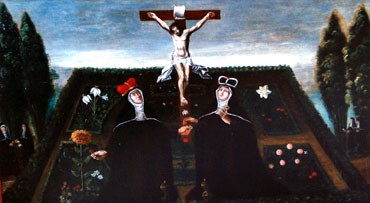 This image is the largest in the series, and was originally placed above the door to the monastery. Currently located at the top of the bench in the aisle of the church. This is the only image without a signature.
This image is the largest in the series, and was originally placed above the door to the monastery. Currently located at the top of the bench in the aisle of the church. This is the only image without a signature.
The composition of the scene is symmetrical and static, what gives the impression of calm and tranquility. Kneeling on both sides of the cross, St. Bridget and St. Catherine with a cheerful smile are looking at the cross, holding flowers in their hands. Adoration takes place in the garden, which in the picture was taken in an awkward perspective.
Apart from the observation of a lack of painter's skills, it can be noticed that in this way he emphasized the virtues of garden, its closure - a small garden surrounds the hedge, unity and exclusion from the world. In such perspective nothing covers the second plan, everything is arranged in order, this impression strengthens the geometric arrangement of beds. And besides - and what is most important here - in this way it is clearly emphasized that the garden is set on a square plan. The square was a symbol of order in chaos. In the garden we can also see a circle that is formed by beds, with a cross placed in its cental point.
The circle by its circular shape is the most perfect form: it has no beginning or end. God was compared to a circle. This shape is also a symbolic sign of participation in glory, so the saints were depicted with halos. Saints Bridget and Catherine are kneeling on flower beds, but if you look closely at them, it turns out that with this miserable perspective the painter managed to surround these two figures by a circle. The artist thus showed the idea of their presence both in a paradise reality, where they live after death, but also on earth, as they remain here as a model to follow by nuns. The garden in art was often used as a symbol of the convent surrounded by the wall of the monastic rule. This scene is taking place when saints receive crowns, adore Christ the Crucified, and the faith is confirmed not only by words but also by actions, what is proved by the lily helding together by Bridget and Catherine at the feet of Christ. This image represents the Order of St. Bridget. In the garden we see not only lilies and roses, which are the largest flowers here, but also narcissuses, violets and tulips, which presence can be considered as an indication of virtues practiced in the Bridgettine's Order, e.g. violets symbolize humility.






